Services
Gum Disease Laser Therapy
Virtually Painless, More Natural Dentistry
Heat, vibration and pressure are the primary causes of pain associated with the use of the traditional dental drill. Since cutting both hard and soft tissues (teeth and gums) with the WaterLase does not generate heat, vibration or pressure, many dental procedures can be performed nearly pain-free with fewer shots, less need for anesthesia, less use of the drill and fewer numb lips! Additionally, using the WaterLase for gum procedures reduces bleeding, post-operative pain, swelling and the need for pain medication in many cases. It’s just a better way to get your dentistry done!

Accuracy & Precision
WaterLase dentists are able to remove tooth enamel decay (the hardest substance in the body), bone and gum tissue precisely while leaving surrounding areas unaffected. This conserves more of the precious tooth structure you were born with, helping you to maintain your natural teeth longer!
Reduced Trauma
High speed drills can cause hairline cracks and fractures in the teeth that eventually lead to future dental problems. WaterLase reduces damage to healthy portions of the tooth and minimizes trauma.
Less Bleeding & Swelling
Due to its conservative cutting action, the WaterLase performs many soft tissue (gum) procedures with little or no bleeding and less post-op swelling.
Fewer Dental Visits
Since you often do not need shots or anesthesia, a WaterLase dentist can perform cavity preps in all areas of the mouth in just one visit. This technology also gives trained WaterLase dentists the ability to perform many procedures that were previously referred to specialists, saving you time and hassle as you address the dental needs of you and your family.
Versatility
The WaterLase is extremely versatile. It can be used for a wide range of hard and soft tissue procedures. From decay removal, cavity preparation, root canals, smile design, gum and bone surgical procedures and many others. Let your WaterLase dentist be a one stop shop for you!
Tooth Extractions
You and Dr. Pham may determine that you need a tooth extraction for any number of reasons. Some teeth are extracted because they are severely decayed; others may have advanced periodontal disease, or have broken in a way that cannot be repaired. Other teeth may need removal because they are poorly positioned in the mouth (such as impacted teeth), or in preparation for orthodontic treatment.
The removal of a single tooth can lead to problems related to your chewing ability, problems with your jaw joint, and shifting teeth, which can have a major impact on your dental health.
To avoid these complications, in most cases, Dr. Pham will discuss alternatives to extractions as well as replacement of the extracted tooth.
The Tooth Extraction Process
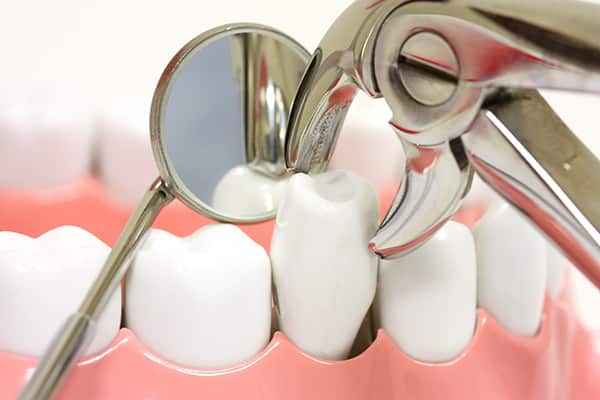
At the time of extraction the doctor will need to numb your tooth, jaw bone and gums that surround the area with a local anesthetic.
During the extraction process you will feel a lot of pressure. This is from the process of firmly rocking the tooth in order to widen the socket for removal.
You feel the pressure without pain as the anesthetic has numbed the nerves stopping the transference of pain, yet the nerves that transmit pressure are not profoundly affected.
If you do feel pain at any time during the extraction please let us know right away.
Sectioning a Tooth
Some teeth require sectioning. This is a very common procedure done when a tooth is so firmly anchored in its socket or the root is curved and the socket can’t expand enough to remove it. The doctor simply cuts the tooth into sections then removes each section one at a time.
After Tooth Extraction
After tooth extraction, it’s important for a blood clot to form to stop the bleeding and begin the healing process. Bite on a gauze pad for 30-45 minutes immediately after the appointment. If the bleeding or oozing still persists, place another gauze pad and bite firmly for another 30 minutes. You may have to do this several times to staunch the flow of blood.
After the blood clot forms it is important to not disturb or dislodge the clot. Do not rinse vigorously, suck on straws, smoke, drink alcohol or brush teeth next to the extraction site for 72 hours. These activities may dislodge or dissolve the clot and hinder the healing process. Limit vigorous exercise for the next 24 hours, as this increases blood pressure and may cause more bleeding from the extraction site.
After the tooth is extracted you may feel some pain and experience some swelling. An ice pack or an unopened bag of frozen peas or corn applied to the area will keep swelling to a minimum. Take pain medications as prescribed. The swelling usually subsides after 48 hours.
Use pain medication as directed. Call our office if the medication doesn’t seem to be working. If antibiotics are prescribed, continue to take them for the indicated length of time even if signs and symptoms of infection are gone. Drink lots of fluids and eat nutritious, soft food on the day of the extraction. You can eat normally as soon as you are comfortable.
It is important to resume your normal dental routine after 24 hours. This should include brushing and flossing your teeth at least once a day. This will speed healing and help keep your mouth fresh and clean.
After a few days you should feel fine and can resume your normal activities. If you have heavy bleeding, severe pain, continued swelling for 2-3 days, or a reaction to the medication, call our office immediately.
Dental Crowns
Most dentistry looks like dentistry. Our goal is to provide dentistry that is undetectable. We replace existing crowns and fillings with restorations that look and feel like your natural teeth.
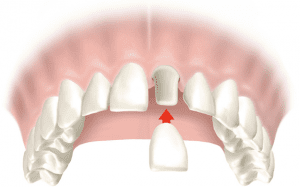 Where damage to a person’s teeth is extreme, and apparently beyond repair, we can use porcelain or porcelain “pasted on gold” crowns to make the smile appear “as new”.
Where damage to a person’s teeth is extreme, and apparently beyond repair, we can use porcelain or porcelain “pasted on gold” crowns to make the smile appear “as new”.
This is an extremely reliable technique for repairing the most severe of dental problems, even permanently replacing missing teeth to offer a complete smile and a functional bite.
We are renowned for the quality of our work and the fantastic changes we make for people using this technology. These treatments are used for a long-lasting correction of major dental problems. It is usual for these treatments to last for 20 to 30 years, which is as close to permanent as dental treatment can get.
Benefits of Dental Crowns
- Replaces missing teeth
- Offers support to misshapen teeth or badly broken teeth
- Looks completely natural
- Fixes “smiles” and functional chewing problems
How long does it take to fit a dental crown?
Fitting a crown requires at least two visits to our office. Initially, we will remove decay, shape the tooth, and fit it with a temporary crown of either plastic or metal.
On the subsequent visit, we will remove the temporary crown and then fit and adjust the final crown. Finally, we will cement the crown into place and you have a new beautiful looking tooth.
What are the capabilities of crowns?
Crown and bridgework is a very reliable solution for major dental problems caused through accidents, diseases or wear and tear. Major problems can usually be corrected using these techniques. Material used in these repairs is either high-grade porcelain or porcelain bonded to gold. A higher strength of the porcelain and gold materials is recommended to treat the most serious of dental problems. Where accidental damage has occurred, resulting in lost teeth, or where teeth have broken away through excessive wear, or as the result of old fillings breaking, crowns and/or bridges can be used as a long-term solution.
Many people have unexplained pain from filled back teeth, which is usually due to hairline cracks in the chewing part of the tooth. Placing crowns on these teeth relieves the pain and allows a return of full dental function for these teeth. In front teeth, older fillings can both weaken the teeth and cause “appearance” problems due to staining or chipping. Porcelain crowns and bridges are suitable in cases where porcelain veneers are not. In teeth with root canal fillings, crowns can prevent breakage.
Dental Implants
Dental implants are designed to provide a foundation for replacement teeth that look, feel and function like natural teeth. The person who has lost teeth regains the ability to eat virtually anything and can smile with confidence, knowing that teeth appear natural and that facial contours will be preserved. The implants are tiny titanium posts which are placed into the jaw bone where teeth are missing. The bone bonds with the titanium, creating a strong foundation for artificial teeth. In addition, dental implants can help preserve facial structure, preventing the bone deterioration which occurs when teeth are missing.
Dental implants are changing the way people live! With them, people are rediscovering the comfort and confidence to eat, speak, laugh and enjoy life.
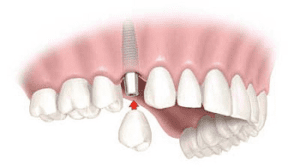 Evaluation for Dental Implants
Evaluation for Dental Implants
If, like many others, you feel implant dentistry is the choice for you, we ask that you undergo a dental/radiographic examination and health history. During these consultation visits, your specific needs and considerations will be addressed by either Dr. Pham or by an Oral and Maxillofacial Surgeon referred by our practice. Your questions and concerns are important to us and our team will work with you very closely to help make your procedure a success.
Dental Implant Procedure
Dental implants are metal anchors, which act as tooth root substitutes. They are surgically placed into the jaw bone. Small posts are then attached to the implant, which protrude through the gums. These posts provide stable anchors for artificial replacement teeth.
For most patients, the placement of dental implants involves two surgical procedures. First, implants are placed within your jaw bone. For the first three to six months following surgery, the implants are beneath the surface of the gums, gradually bonding with the jaw bone. You should be able to wear temporary dentures and eat a soft diet during this time. At the same time, your restorative dentist designs the final bridgework or denture, which will ultimately improve both function and aesthetics.
After the implant has bonded to the jaw bone, the second phase begins. The surgeon will uncover the implants and attach a small healing collar. Dr. Pham can then start making your new teeth. An impression must be taken. Then posts or attachments can be connected to the implants. The replacement teeth are then made over the posts or attachments. The entire procedure usually takes six to eight months. Most patients do not experience any disruption in their daily life.
Denture Relines
New dentures will typically fit your mouth very securely as it has been designed specifically for your gums. As time goes on, your gum tissues will change and the fit of the denture will become more loose and thus more prone to movement inside your mouth. Having the denture professionally relined every one to two years will keep the denture secure and functional.
 Hard Reline
Hard Reline
All full dentures should have a hard reline every two years. Diamond Dental removes a layer of plastic from the dentures interior surface, and then fills the denture with a putty-like material which conforms to the contours of your mouth creating an accurate impression. The denture is sent to the lab where it is adjusted to the new shape of your gum tissue. This results in maximum contact between the denture and your mouth.
Soft Reline
Some patients are unable to wear ordinary dentures because of tender gums or sore spots. Diamond Dental may recommend relining the denture with a material that stays pliable for one to two years before needing replacement. This material is much less likely to give the patient sore spots than the standard hard reline acrylic. Patients experiencing these problems may also consider a more permanent solution of implant retained dentures.
Temporary Relines
If dentures have not been serviced in quite some time, a patient’s gums may be red, swollen, or misshapen. This creates problems in taking impressions for a new hard or soft reline and may lead to a denture that would perpetuate the problem.
A temporary, or palliative (medicated) reline material may be recommended to allow the inflammation to subside. This reline makes the denture fit much more tightly, and is usually soft and pliable. After a few weeks, the gums return to a more normal state. The patient is then ready for his new denture or hard reline.
Denture Care
Advice and tips on caring for your dentures
- Only your dental professional is qualified to diagnose your oral health and adjust your denture or partial.
- Dentures should be brushed inside and outside daily with a soft, large nylon denture tooth brush with round-ended bristles.
- Use denture creams instead of toothpastes, which are too abrasive and will scratch your denture. Rinse with cold water.
- Dentures warp if placed in hot water.
- Inspect your denture regularly for worn teeth.
- Worn and stained dentures can make you look older and cause your dentures to function poorly.
- Discuss all your current medications with your doctor and dental professional.
- Be sure to visit your dental professional regularly.
- Have loose dentures checked immediately as they can cause friction and pressure on the gum tissues and bones.
- When not in use, cover dentures with water or a denture-cleaning solution to prevent them from drying out.
- Most dental insurance policies provide coverage for new dentures every 5 years.
Dentures
A denture or a complete denture as it is often called, is an appliance that is inserted in the mouth, replaces natural teeth and provides support for the cheeks and lips.
 Most dentures are made of acrylic and can be fabricated two different ways.
Most dentures are made of acrylic and can be fabricated two different ways.
- A conventional denture is made after all teeth have been extracted and the tissues (gums) have healed.
- An immediate denture is fabricated and inserted immediately after the teeth are extracted and the tissues are allowed to heal under the denture.
- An upper denture has acrylic, usually flesh colored, that covers the palate (roof of the mouth).
- A lower denture is shaped like a horseshoe to leave room for the tongue.
The teeth are made of plastic, porcelain or a combination thereof. Dentures can be fabricated to fit over endodontically treated teeth and a complete denture can be attached to dental implants to allow for a more secure fit of the appliance.
Dentures over a normal course of time will wear and need to be replaced or relined in order to keep the jaw alignment normal. The alignment will slowly change as the bone and gum ridges recede or shrink due to the extraction of the teeth. Regular dental examinations are still important for the denture wearer so that the oral tissues can be checked for disease or change.
Dental Sealants
Highly effective in preventing decay on the biting surfaces of your chewing teeth, dental sealants are a simple procedure in which a tooth-colored acrylic “coating” is painted onto the surface of the tooth.
Sealants effectively “seals” the deep grooves, acting as a barrier and protecting enamel from plaque and acids.
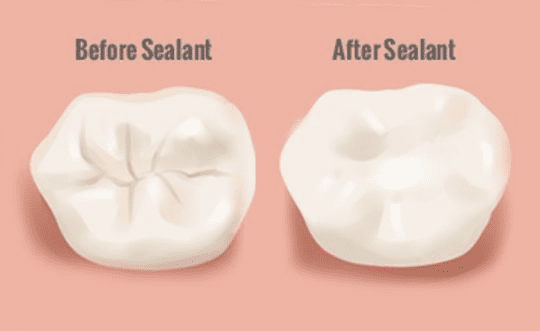
Sealants protect the depressions and grooves of your teeth from food particles and plaque that brushing and flossing can’t reach.
Easy to apply, sealants take only a few minutes to seal each tooth. Sealants hold up well under the force of normal chewing and can last several years before a reapplication is needed.
Children and adults can benefit from sealants in the fight against tooth decay.
 12 Apr 2024
12 Apr 2024
Dental Filings
Many people still have silver/mercury fillings in their mouths from years past. These fillings are not particularly pleasing to the eye, and we know that by unavoidable design, silver/mercury fillings ultimately result in a weaker tooth structure. Porcelain inlays and Tooth Colored Restorations (onlays) create fillings that are not only beautiful (or unnoticeable) but also add strength to weakened teeth. These restorations are aesthetically pleasing and very strong thanks to new bonding technologies.
 Disadvantages of Silver fillings
Disadvantages of Silver fillings
Silver fillings have many drawbacks. The edges of the silver filling can wear down, become weak or break. This results in the tooth not being protected and lets cavities get started once again. With age, the metal of a silver filling expands, contracts, and can split.
Silver fillings contain 50 percent mercury. They can corrode, leak and cause stains on your teeth and gums.
Fortunately, silver fillings can safely be replaced with Tooth-Colored Restorations.
Advantages of Tooth-Colored Restorations
There are many advantages to tooth-colored restorations. Resin onlays are bonded to the teeth creating a tight, superior fit to the natural tooth. Such restorations can be used in instances where much of the tooth structure has been lost. The tooth remains intact and stronger.
Since the resin used in tooth-colored restorations contain fluoride this can help prevent decay. The resin wears like natural teeth and does not require placement at the gum line, which is healthier for your gums!
The result is a beautiful smile!
Replacing Silver Fillings with a Tooth Colored Restoration
You can have your silver fillings replaced with tooth-colored restorations (onlays). This process requires two appointments.
Your First Appointment:
The old filling is removed along with any additional decay.
An impression is made of your teeth. A model of your teeth is made and sent to the lab.
A temporary onlay is placed on the tooth.
At the Lab:
A resin is carefully placed into the model of your teeth. It is then designed to look natural.
Your Second Appointment:
The temporary onlay is removed.
A conditioning gel is placed on your tooth to prepare it for the new onlay.
Bonding cement is placed on the tooth and a high intensity light bonds the resin to the tooth.
The tooth is then polished.
Your teeth are restored to a natural look and feel, they are stronger and the tooth is protected!
 12 Apr 2024
12 Apr 2024
Porcelain Veneers
What are porcelain veneers?
Porcelain veneers are thin shells of ceramic that bond directly to the front surfaces of the teeth. They are an ideal choice for improving your smile and have become increasingly popular due to their simplicity and versatility.
Placing custom veneers requires a high degree of technical skill as well as attention to cosmetic detail. We place veneers routinely, and design each case individually to match and enhance the characteristics of each patient’s smile.
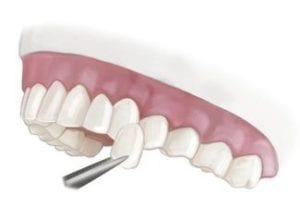 Do porcelain veneers look like normal teeth?
Do porcelain veneers look like normal teeth?
When bonded to the teeth, the ultra-thin porcelain veneers are virtually undetectable and highly resistant to coffee, tea, or even cigarette stains. For strength and appearance, their resemblance to healthy, white tooth enamel is unsurpassed by other restorative options.
How durable are porcelain veneers?
With proper care, porcelain veneers will brighten your smile for well over a decade.
Dr. Pham will ensure that your veneers are crafted from the highest quality porcelains and are bonded with the most advanced and proven materials available.
Refraining from using your veneers as tools to open and cut things will prolong their life, and if accidental breakage or damage occurs, it is usually possible to replace only the veneer involved.
- 1
- 2